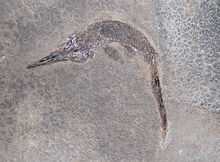Mixosaurus
| Mixosaurus Temporal range: Mid Triassic | |
|---|---|
 | |
| Mixosaurus cornalianus | |
| Scientific classification | |
| Kingdom: | Animalia |
| Phylum: | Chordata |
| Class: | Sauropsida |
| Order: | Ichthyosauria |
| Family: | Mixosauridae |
| Genus: | Mixosaurus Baur, 1887 |
| Species | |
| |




Mixosaurus is an extinct genus of ichthyosaur. Fossils of Mixosaurus have been found all over the world - China, Timor, Indonesia, Italy, Spitsbergen, Svalbard, Canada, Alaska, and Nevada and it was the most common genus of Triassic Ichthyosaur. [1] It was named in 1887 by George H. Baur. The name means "Mixed Lizard", and was chosen because it appears to have been a transitional form between the eel-shaped Ichthyosaurs such as Cymbospondylus and the later dolphin-shaped ichthyosaurs, such as Ichthyosaurus. Baur named Mixosaurus as a new genus because its forefin was sufficiently different from that of Ichthyosaurus. [1]
Description
Mixosaurus was a small to medium sized ichthyosaur, not growing more than 2 metres in total length with small species not growing more than 1 metre. It possessed a long tail with a low fin, suggesting it could have been a slow swimmer, but also possessed a dorsal fin for stability in the water. The paddle-like limbs were made up of five toes each, unlike the three toes found in later Ichthyosaurs. Noteworthy, however, is that each toe had more individual bones than is usual in reptiles, and the front limbs were longer than the back limbs, both adaptations typical of later ichthyosaurs. The jaws were narrow, with several sharp teeth, that would have been ideal for catching fish.[2] They had relatively large skulls compared to their bodies, unlike the basal ichthyosaurs, but resembled fish-shaped ichthyosaurs that appeared later. They had around 50 vertebrae in front of the pelvic girdle, around twice as many as terrestrial diapsids.[3]
Species
There are 3 species of Mixosaurus currently recognised, Mixosaurus cornalianus, Mixosaurus panxianesis and Mixosaurus kuhnschnyderi [4] They share many similar characteristics throughout the cranial and post cranial with the main differences morphology occurring in the dental region. Examples of the dental variation are the extent of the dental groove in the upper jaw, the shape and size of the teeth and the number of rows of teeth [1]
Mixosaurus cornalianus
Many specimens of Mixosaurus cornalianus have been found from the Middle Triassic of Monte San Giorgio and the Tessin areas on the border of Italy and Switzerland.
Mixosaurus cornalianus is the only Triassic ichthyosaur for which completely articulated skeletons have been found. Many specimens have been collected but Mixosaurus cornalianus is not well studied, this is because all of the known specimens have been compressed during the preservation process.
Mixosaurus cornalianus has a sagittal crest associated with the expansion of the upper temporal fenestra. This indicates that it had exceptionally strong jaw muscles. [1]
Mixosaurus panxianensis
Mixosaurus panxianensis was discovered in the Middle Triassic of the Guizhou Province, China. The specimens have been found in the Guanling Formation, which consists of thinly bedded bituminous limestones and marls.
The specimens found have important Mixosaurid characteristics such as a long sagittal crest along the top of the skull but is seen as a different species because there is no external contact between the jugal and the quadratojugal.
Articulated skeletons have been found and the centra of the vertebrae are higher than they are long. This is evidence for its transitional position between basal early Triassic ichthyosaurs and more derived Jurassic and Cretaceous species; who have disc shaped circular centra of the vertebrae. [4]
Taxonomic Controversies
In recent years the taxonomy and phylogeny of Mixosaurid Ichthyosaurs has been a controversial topic.
Most recently, Mixosauridae has been separated into Mixosaurinae and the sister group Phalarondontinae. Mixosauridae containing M. cornalianus, M. kuhnschnyderi and M. panxianensis, Phalarodon contains P. fraasi, P. callawayi and P. atavus.
Mixosaurids are characterised by a relatively short and wide humerus and Phalarodon are characterised by the lack of a dental groove in the upper jaw. Phalarodon fossils are found in every major Mixosaur locality.
Mixosaurid species declared as nomen dubium, meaning the description was insufficient to fully classify them as a species, are M. maotaiensis, M. helveticus, M. timorensis, M. major, M. timorensis, M.nordenskioeldii. [5] [4] [6]
It was suggested that Tholodus schmidi should be included in Mixosauridae but only dental material has been found so it is difficult to assign it to a genus. [4]
References
- ↑ 1.0 1.1 1.2 1.3 Motani, R., et al (1999). "The skull and Taxonomy of Mixosaurus (Ichthyoptergia)". Journal of Paleontology 73: 924–935.
- ↑ Palmer, D., ed. (1999). The Marshall Illustrated Encyclopedia of Dinosaurs and Prehistoric Animals. London: Marshall Editions. p. 79. ISBN 1-84028-152-9.
- ↑ Motani, R., et al (1996). "Eel like swimming in the earliest ichthyosaurs". Nature 382: 347–388. doi:10.1038/382347a0.
- ↑ 4.0 4.1 4.2 4.3 Jiang, D., et al (2006). "A new mixosaurid ichthyosaur from the Middle Triassic". Journal of Vertebrate Paleontology 26: 60–69.
- ↑ Schmitz., et al (2010). "The taxonomic status of Mixosaurus nordenskioeldii". Journal of Vertebrate Palaeontology 25: 983–985.
- ↑ Prof. Dr. H.D Sues, ed. (2003). Handbook of Paeoherpetology, Part 8, Ichthyopterygia. Munchen: Friedrich Pfeil. p. 175.